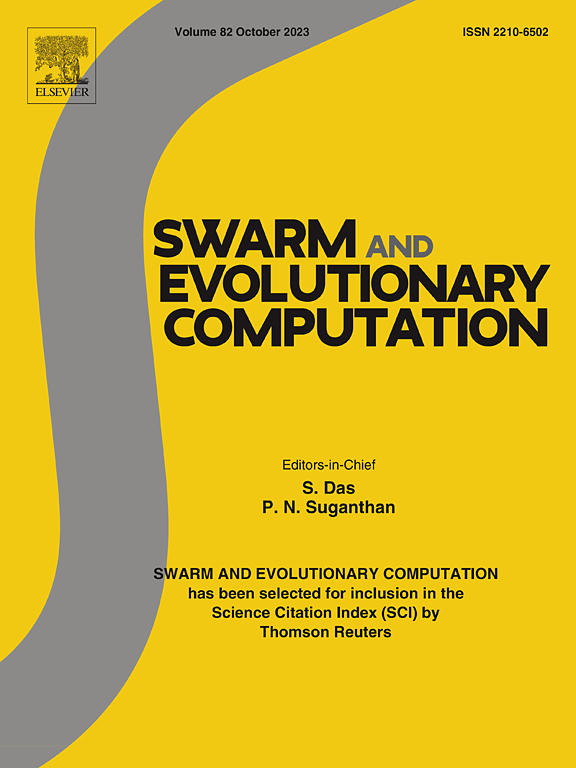增强正弦离散化的多目标安全约束最优无功调度
IF 8.5
1区 计算机科学
Q1 COMPUTER SCIENCE, ARTIFICIAL INTELLIGENCE
引用次数: 0
摘要
带安全约束的最优无功调度(ORD)是一个非线性优化问题,用于评估电力系统中预先确定的一组突发事件的影响。它的分辨率可以帮助运营商确定安全稳定的操作条件。此外,该问题还涉及确定控制组件的最佳设置,以实现改进的系统配置。当考虑更复杂的建模时——结合多个目标和离散的决策变量——大多数现有的方法都很难找到好的可行的解决方案,特别是当偶然事件的数量增加时。针对多目标混合整数非线性规划(MINLP)问题,提出了一种基于进化粒子群优化(EPSO)的求解方法,并引入正弦离散函数。在经典的粒子群算法中,由于考虑离散变量,通常需要采用标量运算来处理离散变量,从而降低了原有粒子群算法的性能。然而,正弦函数的建议应用允许对用于协调无功电源的离散变量进行精确建模,同时最小化有功功率损耗和发电机无功输出(即增加无功裕度),而不会损失精度和收敛速度。我们对IEEE-118和IEEE-300总线系统进行了详尽的测试。其中包括对最具影响力参数的敏感性分析,以证明所提议的多目标模型在提供可靠的权衡解决方案方面的有效性和稳健性,这些解决方案既满足不同目标的技术要求,也满足不同目标的安全要求。与其他已知的元启发式算法进行了比较,证实了该方法在求解时间和求解质量方面的良好性能。本文章由计算机程序翻译,如有差异,请以英文原文为准。
Multiobjective security-constrained optimal reactive dispatch with enhanced sinusoidal discretization
Optimal Reactive Dispatch (ORD) with security constraints is a nonlinear optimization problem used to assess the impacts of predefined sets of contingencies in power systems. Its resolution helps operators identify secure and stable operating conditions. Additionally, the problem involves determining the optimal settings of control components to achieve an improved system configuration. When more complex modeling is considered – incorporating multiple objectives and discrete decision variables – most existing approaches struggle to find good feasible solutions, particularly as the number of contingencies increases. Our contribution to this multi-objective mixed-integer nonlinear programming (MINLP) problem is a solution method based on Evolutionary Particle Swarm Optimization (EPSO), enhanced with a sinusoidal discretization function. With classical PSO-based methods, the consideration of discrete variables usually implies adapting scalar operations to operate with discrete variables, which degrades the original PSO algorithm. However, the proposed application of the sinusoidal function allows for accurate modeling of discrete variables used to coordinate reactive power sources, while simultaneously minimizing active power losses and generator reactive power outputs (i.e., increasing reactive margins) without losing accuracy and convergence speed. We conducted exhaustive tests on the IEEE-118 and IEEE-300 bus systems. These included a sensitivity analysis on the most influential parameters to demonstrate the effectiveness and robustness of the proposed multi-objective model in delivering reliable trade-off solutions that satisfy both technical and safety requirements across different objectives. Comparisons with other known metaheuristic algorithms have also been done, which confirmed the good performance of the proposed method in terms of resolution time and solution quality.
求助全文
通过发布文献求助,成功后即可免费获取论文全文。
去求助
来源期刊

Swarm and Evolutionary Computation
COMPUTER SCIENCE, ARTIFICIAL INTELLIGENCEC-COMPUTER SCIENCE, THEORY & METHODS
CiteScore
16.00
自引率
12.00%
发文量
169
期刊介绍:
Swarm and Evolutionary Computation is a pioneering peer-reviewed journal focused on the latest research and advancements in nature-inspired intelligent computation using swarm and evolutionary algorithms. It covers theoretical, experimental, and practical aspects of these paradigms and their hybrids, promoting interdisciplinary research. The journal prioritizes the publication of high-quality, original articles that push the boundaries of evolutionary computation and swarm intelligence. Additionally, it welcomes survey papers on current topics and novel applications. Topics of interest include but are not limited to: Genetic Algorithms, and Genetic Programming, Evolution Strategies, and Evolutionary Programming, Differential Evolution, Artificial Immune Systems, Particle Swarms, Ant Colony, Bacterial Foraging, Artificial Bees, Fireflies Algorithm, Harmony Search, Artificial Life, Digital Organisms, Estimation of Distribution Algorithms, Stochastic Diffusion Search, Quantum Computing, Nano Computing, Membrane Computing, Human-centric Computing, Hybridization of Algorithms, Memetic Computing, Autonomic Computing, Self-organizing systems, Combinatorial, Discrete, Binary, Constrained, Multi-objective, Multi-modal, Dynamic, and Large-scale Optimization.
 求助内容:
求助内容: 应助结果提醒方式:
应助结果提醒方式:


